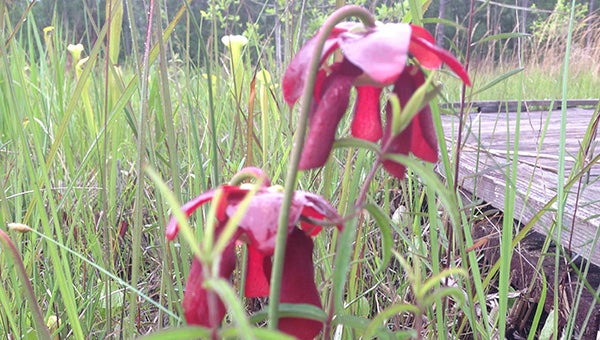Arboretum Paths: Hungry carnivorous plants in the bog
Published 7:00 am Wednesday, April 27, 2016
We were delighted that hundreds of visitors came this past weekend to our Spring Native Plant Sale. Many of these persons also stayed to walk the grounds, touring the Aquatic, Woodland and Savanna exhibits.
The Arboretum’s Savanna Exhibit parallels Ridge Road, making up about one third of our public garden. Two bogs are located within the exhibit. One is at the northern tip of the Arboretum. Over the last ten years, the clusters of yellow pitcher plants in this area have greatly expanded, and many stunning Mississippi wildflowers such as the purple-spiked Liatris and scarlet pine lilies have become more common there.
At the southern tip of the Savanna Exhibit lies another bog, which we refer to as “the” Pitcher Plant Bog. What visitors are usually unaware of is that we conduct controlled burns here every year in January or February. As we have fewer visitors in the winter, most are not acquainted with the bog in its blackened state.
Following a winter burn, the grasses and perennials quickly turn green again, spurred by nutrient-rich ash left by the fire. Soon, flowers of the yellow pitcher plants (Sarracenia alata) unfurl. The blooms are called “buttercups” by local residents, and their hollow leaves contain digestive enzymes that dissolve insects which tumble into the structures.
Carnivorous plants have developed other methods of obtaining their nitrogen in the bogs’ acidic, nutrient-poor soil, through trapping and digesting insects. Pitcher plants are a species of carnivorous plant that trap and digest insects by attracting them with sweet-smelling nectar. The insects’ exit from the tubular leaves is prevented by a thick forest of downward facing hairs on the inside surface of the leaves.
As coastal wet pine savanna habitat is increasingly lost to development, there are fewer opportunities to spot carnivorous plants. At the Crosby Arboretum, managing these areas by consistent controlled burning suppresses the underbrush and promotes a diverse collection of native plants that are well-adapted to periodic fire in these bog habitats, including carnivorous species.
A stroll last week through the south Pitcher Plant Bog provided a perfect opportunity to study these plants. We found clusters of dwarf sundews (Drosera brevifolia) growing against the bare earth, covered in tiny sparkles of ruby “dew”. We were also awed when state botanist Heather Sullivan pointed out another variety of sundew, a threadleaf sundew (Drosera tracyi). The plant is a mass, almost a foot in height, of long, upright thin leaves covered with drops of sticky dew that trap insects.
Search the Internet for an image of Drosera tracyi and you will see why we were so delighted to find this one! If you enjoy growing unusual plants, just add the keyword “nursery” to the Latin name to find growers of the plant, as it is an easy one to grow in a terrarium.
The maroon blooms of the parrot pitcher plant (Sarracenia psittacina), a compact species only four to six inches tall, are also on display in the bog. Many of these plants were relocated several years ago from a coastal construction site and have adapted well to their new home.
Some species of insects and arachnids co-exist with pitcher plants, and never fall victim to their allure. We often see a familiar little moth when we peer inside the “mouths” of the yellow pitcher plants. At one time we thought we were doing a good deed when we released them, but after reading up on these insects have learned they are doing just fine and dandy in there.
Love monarch butterflies? Bring your family to the “Amazing Life Cycle of the Monarch Butterfly,” onSaturday, April 30, from 10 to 11 a.m., with nature photographer and butterfly enthusiast Gregory Nordstromand wife Becky, who raise monarch butterflies and enjoy sharing their passion with others.
Saturday, May 7 at 10:00 a.m. is our Painted Pot for Mother’s Day Children’s Workshop. Learn all about (live) Snakes in a program with Terry Vandeventer on Saturday, May 14 at 10:00 a.m.
For more information, visit www.crosbyarboretum.msstate.edu or call 601-799-2311 to sign up for programs. The Arboretum is open Wednesday through Sunday from 9 a.m. to 5 p.m. and located in Picayune, off I-59 Exit 4, at 370 Ridge Road (south of Walmart and adjacent to I-59).
Patricia R. Drackett, Director and Assistant Extension Professor of Landscape Architecture
The Crosby Arboretum, Mississippi State University Extension Service






